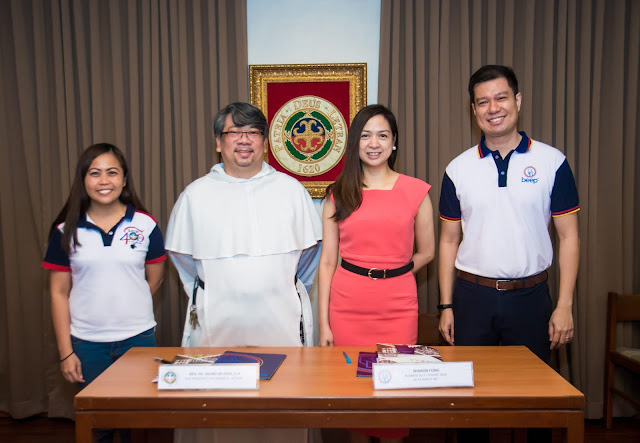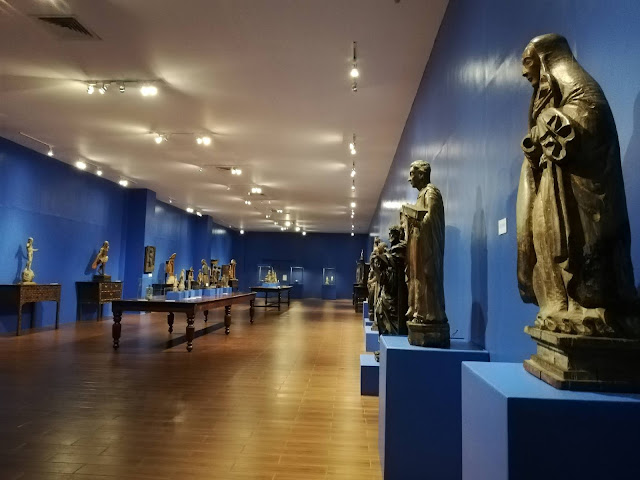The museum is located in two important reconstructions inside the walled city: the San Ignacio Church and the Mission House of the Society of Jesus. The museum is envisioned to house the period art collections of IA that includes ecclesiastical art, furniture, vestments and textiles, and other artifacts.
The museum's current in-house exhibition presents the story of the evangelization of the Philippines from the perspective of the Filipinos. It explores changes in the "Filipino" psyche as colonization introduced a new religion and culture to the natives The exhibition is able to highlight Filipino artistry and craftsmanship that was a result of the merging of the indigenous and the foreign, in the form of religious images belonging to the IA collection.
The exhibition has six components:
1. The Immaculate Conception -
When the first missionaries arrived in 1565, they opined that the women of the islands as "unchaste." They were bare-breasted and bathe in the rivers with men. The scandalized missionaries, therefore, set up a model for the women to emulate: Mary-inviolate, pure, immaculate.
Inmaculada Concepción images from the Intramuros Administration Collection chronicle the local evolution of her iconography. Experimentations led carvers to self-assertion, drawing from their own culture and new-found faith to honor Mary.
2. The Religious Order
Spain's overseas expansion had a two-fold purpose. The first objective, to gain more colonies for the Spanish Empire; the second was to "Christianize" the inhabitants, who were largely animists who believed that spirits inhabit their surroundings. To achieve such goals, Spain introduced a system called "reducción" which resulted in the subjugation of the early "Filipinos," for it kept them "bajo las campanas" (under the church bells). The spatial proximity between the colonizers and the colonized eased religious indoctrination and political subjugation. Five religious orders played an important role in the evangelization of the archipelago. The Augustinians arrived in the Philippines in 1565, followed by the Franciscans arrived in 1578, the Jesuits in 1581, Dominican Order in 1587, and lastly the Recollects (Discalced Augustinians) in 1606.
3. The Patronato Real and the establishment of Parishes
The Royal Certificate of Patronage in the Indies (Real Patronato Indiano) consolidated the colonial governance of the Philippines. By the time the Patronato Real was issued, the construction of churches, cathedrals, convents, hospitals, among others, all fell under royal authorization. Royal consent was needed because each new parish obliged the king to allocate funds from the Hacienda Real to provide the new parish priest with an annual stipend, as well as furnish each new parish church with the required sacred vessels. On the other hand, the citizens of every town were required to provide building materials and labor for the construct of their parish church and convent.
4. Religious Colonial Paintings
Amid the disappearance of the ancient script of baybayin, the indio's deprivation of Spanish, and the scarcity of books in the local languages, the Spanish missionaries converted the lowland natives to Christianity, especially aided by the images of admonition depicted in paintings and statues, vicarious
experiences induced by dramas and rituals, and the consolation of songs. The rapid conversion of the lowland population brought to the fore the need for more paintings and statues. But facing the difficulty to obtain these items from Spain or from Mexico, the Spanish missionaries looked for local supply. At first, they turned to the Chinese inhabitants in the Philippines living in the Parian settlements outside Intramuros, and then later on to indio talents Painted representations may be classified as instructional, devotional or attendant. The distinctive preferences of the Philippine colonial community in its choice of devotion to particular saints were influenced by the frequency of occurrences of specific vicissitudes or the causes of suffering, and the resulting terror from these conditions. Hence, the outstanding number of San Roque (St.Roch), the patron against the plague, San Isidro Labrador (St. Isidore the Farmer), the patron of farmers, and San Vicente Ferrer (St. Vincent Ferrer), the patron saint against all disasters and intercession of impossible cases.



5. The establishment of a parish and sacred vessels
Under the Patronato Real or Royal Patronage that was m effect from the first colonization efforts by Miguel Lope de Legazpi in 1571, and until the United States bought the colony from Spain in 1898, no parish or Pueblo (town) could be established in the Philippines without the consent of the King.
This was done either through a Decreto Real or Royal Decree or through a Decreto Superior, a decree signed by the Governor General upon orders of the King.
At the onset, Intramuros was dotted with the provincial houses of relgrous orders, A provincial house had an church or chapel within its precinets, whieh had to be equipped with ecclesiastical silver pieces, As mere churches were built by the orders, the need for silver ecclesiastical objects grew in the late sixteenth to the nineteenth century.
The first silversmiths were Chinese. By the eighteenth century. Filipino silversmiths, descendants of the first Chinese artisans who had by now intermarried for generations with Filipinos and were mostly based in Quiapo were adept in all aspects the silversmith trade They produced many masterpieces and mastered gilding and gold plating.
The burgeoning plantation economy of the 19th century brought in a prevailing air of civic pride that swept the towns. Each vied to have the most beautiful church in the province, so that towering main altar glittering with 23-karat gold leaf became the norm. Larger and richer towns, wanting to make a statement, sheathed their altars with beaten silver, a project that involved a lot of time and kilos of silver coins.
6. The Indio Response
The initial response of the Indio to evangelization was intimate, personal their perception of godhood was tied to their own belief system of the Anito (spirits) and their own native pantheon of gods, being dispensers of good and evil. The carvers were not schooled either their productions described as clumsy even ugly, yet compelling in a visceral sense, In the changing landscape of their own homeland, they felt the comfort of the new faith, because similar to the Anitos, its saints could also intercede for them.
From the extremely naive and unschooled carvings, carving the likenesses of divinity moved into hands of artisans harnessed into production for churches ecclesiastics and more affluent homes.
With an emerging ilustrado class and mercantile economy, expressions of faith and devotion to patron saints took on new meanings, slowly being equated, with wealth and status it is in the realm of folk images, however, where the Flipino santeros achieved originality - unleashing vibrant colors and florid designs and expressive imagery, as in this collection of urnas and relieves.
It is curated by Dr. Esperanza Gatbonton, Gino Gonzales, Dr. Cecilia delaPaz, Santiago Pilar and Martin Tinio.
In the book Philippine Religious Imagery, curator Gatbonton said, "This collection of the Intramuros Administration is extremely valuable because it represents the first real attempt to collect and preserve within the Philippines an important aspect of the country's cultural heritage.
"The collection affords the viewer a panorama of the various styles, and enables him to compare them with the artifacts done abroad in the same medium. We Filipinos have always tended to accept that we were the passive receiver of artistic stimuli from abroad. This collection proves that the Philippines was as much a giver," wrote Gatbonton.
DOT Secretary and Chairperson of the IA Board of Administrators, Bernadette Romulo Puyat said, "IA's dedication in ensuring that the tangible treasures that immortalize our history are now accessible to the public is commendable."
She congratulated IA Administrator Guiller Asido and the cultural workers behind the museum and added, "This project, rooted in passion and a deep love of country, must be emulated and replicated."
"The Department of Tourism will be investing in the promotion of cultural tourism in the years to come. We're doing it not just because we need to expand our tourism products, engage a specific market and increase revenue Cultural tourism is telling the world our narrative. It is also a frame to ensure that our heritage structures and objects such as these will be preserved and enjoyed by our progeny," Puyat said.
The Intramuros Administration is an attached agency of the DOT in-charge of the restoration, development, and promotion of the historic walled city of Intramuros.





















































.jpg)
